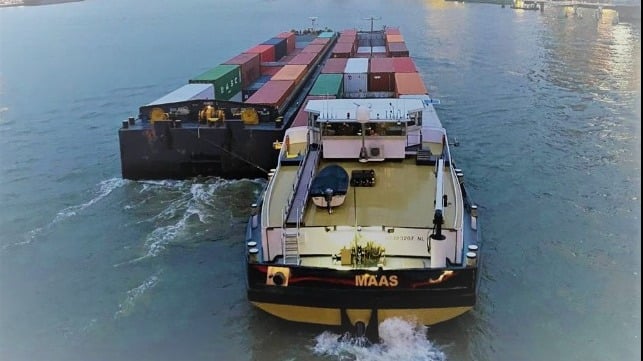Hydrogen Propulsion Conversion for Dutch Inland Vessel

A Dutch inland vessel is going to be converted later this year to operate on a zero-emissions hydrogen propulsion system. The project is viewed as a prototype for the development of a fleet of inland and shortsea vessels that will operate in the region and be available for charter.
The 360-foot inland vessel, Maas, is part of a project being undertaken by Future Proof Shipping, a Dutch company focused on the conversion to green energy. The Holland Shipyards Group’s yard in Hardinxveld will undertake the conversion starting in the third quarter of 2021 with the vessel expected to be back in service in December. Once back in service, the Maas will operate transporting shipping containers between Rotterdam and Antwerp and is expected to reduce greenhouse gas emissions by 2000 CO2e tons annually.
“FPS is excited to be working together with HSG on the retrofitting of the Maas to run entirely on hydrogen. This future-proof ship will truly be a zero-emissions vessel, a vessel to forge the way for a greener and more sustainable inland shipping industry,” said Richard Klatten, CEO of Future Proof Shipping.
Future Proof Shipping goal is to build and operate a fleet of 10 zero-emission inland and short-sea vessels which they will offer for charter. The company is also working to assist other shipowners and operators to make the transition to zero-emissions by supporting them on technical, financial, and commercial aspects as well as project development and management.
The retrofitting will include replacing the internal combustion technology with hydrogen technology, removing both the main engine and gearbox and installing a new modular propulsion system. This will consist of electric motors, hydrogen tanks, a PEM fuel cell system used to convert hydrogen into electricity, and a battery system.
The hydrogen and fuel cell system will be installed in the cargo space of the vessel, with the hydrogen being placed above the fuel cell system in two 40ft containers (approximately 1000kg at 300 bar). The fuel cell system will be triple redundant with 825 kW capacity (to supply propulsion and auxiliary power) and a 504 kWh lithium-ion battery pack for peak shaving, secondary and bridging power. The system will contain a 750V DC bus bar and an e-motor for propulsion.
The compressed hydrogen tanks, the fuel cells, and the battery system will be separate units that can be removed for maintenance or replacement purposes.
This project is supported with funding from the Dutch RVO (Subsidie Duurzaam Scheepvaart scheme), Interreg North Sea Program (via the ZEM Ports NS project), and a stimulation scheme for sustainable inland shipping from the Port of Rotterdam, which is executed by the Expertise en InnovatieCentrum Binnenvaart (EICB).
